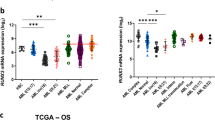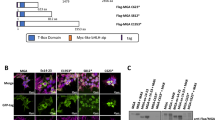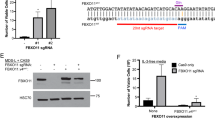Abstract
HTIF1α, a transcription coactivator which is able to mediate RARα activity and functionally interact with PML, is encoded by a gene on chromosome 7q32–34, which is a critical region in acute myeloid leukemias (AML). With the assumption that this gene may be related to AML, we investigated the HTIF1α DNA structure and RNA expression in leukemic cells from 36 M1–M5 AML patients (28 ‘de novo’ and eight ‘secondary’ to myelodysplastic syndrome (MDS)). Abnormal HTIF1α DNA fragments were never found, whereas loss of HTIF1α DNA was observed in the patients with chromosome 7q32 deletion and translocation, and in one case without detectable chromosome 7 abnormality. HTIF1α RNA was found in acute myelocytic leukemic blasts, and was almost undetectable in normal mononuclear cells. The expression varied among the patients: higher in M1 to M3 subtypes, with the highest values in M1; low levels were constantly observed in M4 and M5 AML. In addition, HTIF1α was significantly overexpressed in MDS-related AML (MDR-AML), but not in MDS. We also found that HTIF1α expression was high in myeloid cell lines. In myeloblastic HL60 and promyelocytic NB4 cells, induced to differentiate along the monocytic–macrophage pathway by TPA or vitamin D3, HTIF1α expression decreased, whereas it was maintained at high levels on induction to granulocytic differentiation by RA or DMSO. In K562 cells, HTIF1α RNA levels did not change after hemin-induced erythroid differentiation. These results suggest that HTIF1α could play a role in myeloid differentiation, being distinctly regulated in hematopoietic lineages.
This is a preview of subscription content, access via your institution
Access options
Subscribe to this journal
Receive 12 print issues and online access
$259.00 per year
only $21.58 per issue
Buy this article
- Purchase on Springer Link
- Instant access to full article PDF
Prices may be subject to local taxes which are calculated during checkout




Similar content being viewed by others
References
Le Douarin B, vom Baur E, Zechel C, Heery D, Heine M, Vivat V, Gronemeyer H, Losson R, Chambon P . Ligand-dependent interaction of nuclear receptors with potential transcriptional intermediary factors (mediators) Philos Trans R Soc Lond B Biol Sci 1996 351: 569–578
Remboutzika E, Lutz Y, Gansmuller A, Vonesch JL, Losson R, Chambon P . The putative nuclear receptor mediator TIF1 α is tightly associated with euchromatin J Cell Sci 1999 112: 1671–1683
Fraser RA, Heard DJ, Adam S, Lavigne AC, Le Douarin B, Tora L, Losson R, Rochette-Egly C, Chambon P . The putative cofactor TIF1alpha is a protein kinase that is hyperphosphorylated upon interaction with liganded nuclear receptors J Biol Chem 1998 273: 16199–16204
Le Douarin B, Zechel C, Garnier JM, Lutz Y, Tora L, Pierrat P, Heery D, Gronemeyer H, Chambon P, Losson R . The N-terminal part of TIF1, a putative mediator of the ligand-dependent activation function (AF-2) of nuclear receptors, is fused to B-raf in the oncogenic protein T18 EMBO J 1995 14: 2020–2033
Thenot S, Henriquet C, Rochefort H, Cavailles V . Differential interaction of nuclear receptors with the putative human transcriptional coactivator hTIF1 J Biol Chem 1997 272: 12062–12068
Le Douarin B, You J, Nielsen AL, Chambon P, Losson R . TIF1alpha: a possible link between KRAB zinc finger proteins and nuclear receptors J Steroid Biochem Mol Biol 1998 65: 43–50
Gandini D, Pandolfi PP . Cloning and characterization of HPRR: a gene related to PML Blood 1994 84 (Suppl. 1): 439a
Saurin AJ, Borden KL, Boddy MN, Freemont PS . Does this have a familiar RING? Trends Biochem Sci 1996 21: 208–214
Borden KL, Boddy MN, Lally J, O'Reilly NJ, Martin S, Howe K, Salomon E, Freemont PS . The solution structure of the RING finger domain from the acute promyelocytic leukaemia proto-oncogene PML EMBO J 1995 14: 1532–1541
Longo L, Pandolfi PP, Biondi A, Rambaldi A, Mencarelli A, Lo Coco F, Diverio D, Pegoraro L, Avanzi G, Tabilio A, Zangrilli D, Alcalay M, Donti E, Grignani F, Pelicci PG . Rearrangements and aberrant expression of the retinoic acid receptor alpha gene in acute promyelocytic leukemias J Exp Med 1990 172: 1571–1575
Borrow J, Goddard AD, Sheer D, Solomon E . Molecular analysis of acute promyelocytic leukemia breakpoint cluster region on chromosome17 Science 1990 249: 1577–1580
de The H, Chomienne C, Lanotte M, Degos L, Dejean A . The t(15;17) translocation of acute promyelocytic leukemia fuses the retinoic acid receptor alpha gene to a novel transcribed locus Nature 1990 347: 558–561
Pandolfi PP . Oncogenes and tumor suppressors in the molecular pathogenesis of acute promyelocytic leukemia Hum Mol Genet 2001 10: 769–775
Zhong S, Delva L, Rachez C, Cenciarelli C, Gandini D, Zhang H, Kalantry S, Freedman LP, Pandolfi PP . A RA-dependent, tumour-growth suppressive transcription complex is the target of the PML-RARalpha and T18 oncoproteins Nat Genet 1999 23: 287–295
Miki T, Fleming TP, Crescenzi M, Molloy CJ, Blam SB, Reynolds SH, Aaronson SA . Development of a highly efficient expression cDNA cloning system: application to oncogene isolation Proc Natl Acad Sci USA 1991 88: 5167–5171
Klugbauer S, Rabes HM . The transcription coactivator HTIF1 and a related protein are fused to the RET receptor tyrosine kinase in childhood papillary thyroid carcinomas Oncogene 1999 18: 4388–4393
Venturini L, You J, Stadler M, Galien R, Lallemand V, Koken MH, Mattei MG, Ganser A, Chambon P, Losson R, De The H . TIF1gamma, a novel member of the transcriptional intermediary factor 1 family Oncogene 1999 18: 1209–1217
Bernstein R, Philip P, Ueshima Y . Fourth International Workshop on Chromosomes in Leukemia 1982: abnormalities of chromosome 7 resulting in monosomy 7 or in deletion of the long arm (7q−): review of translocations, breakpoints, and associated abnormalities Cancer Genet Cytogenet 1984 11: 300–303
Koike M, Tasaka T, Spira S, Tsuruoka N, Koeffler HP . Allelotyping of acute myelogenous leukemia: loss of heterozygosity at 7q31.1 (D7S486) and q33–34 (D7S498, D7S505) Leuk Res 1999 23: 307–310
Specchia G, Cuneo A, Liso V, Contino R, Pastore D, Gentile R, Rocchi M, Castoldi GL . A novel translocation t(1;7)(p36;q34) in three patients with acute myeloid leukemia Br J Haematol 1999 105: 208–214
Tosi S, Scherer SW, Giudici G, Czepulkowski B, Biondi A, Kearney L . Delineation of multiple deleted regions in 7q in myeloid disorders Genes Chromosomes Cancer 1999 25: 384–392
Velloso ER, Michaux L, Ferrant A, Hernandez JM, Meeus P, Dierlamm J, Criel A, Louwagie A, Verhoef G, Boogaerts M, Michaux JL, Bosly A, Mecucci C, Van den Berghe H . Deletions of the long arm of chromosome 7 in myeloid disorders: loss of band 7q32 implies worst prognosis Br J Haematol 1996 92: 574–581
Lowenberg B, Downing JR, Burnett A . Acute myeloid leukemia N Engl J Med 1999 341: 1051–1062
Heaney ML, Golde DW . Myelodysplasia N Engl J Med 1999 340: 1649–1660
Mohr B, Bornhauser M, Thiede C, Schakel U, Schaich M, Illmer T, Pascheberg U, Ehninger G . Comparison of spectral karyotyping and conventional cytogenetics in 39 patients with acute myeloid leukemia and myelodysplastic syndrome Leukemia 2000 14: 1031–1038
Xie D, Hofmann WK, Mori N, Miller CW, Hoelzer D, Koeffler HP . Allelotype analysis of the myelodysplastic syndrome Leukemia 2000 14: 805–810
Mauritzson N, Johansson B, Albin M, Rylander L, Billstrom R, Ahlgren T, Mikoczy Z, Stromberg U, Mitelman F, Hagmar L, Nilsson PG . Survival time in a population-based consecutive series of adult acute myeloid leukemia – the prognostic impact of karyotype during the time period 1976–1993 Leukemia 2000 14: 1039–1043
Trayner ID, Bustorff T, Etches AE, Mufti GJ, Foss Y, Farzaneh F . Changes in antigen expression on differentiating HL60 cells treated with dimethylsulphoxide, all-trans retinoic acid, alpha1, 25-dihydroxyvitamin D3 or 12-O-tetradecanoyl phorbol-13-acetate Leuk Res 1998 22: 537–547
Aguiari G, Piva R, Manzati E, Mazzoni E, Augello G, Chiari E, Moretti S, Neri LM, del Senno L . K562 erythroid and HL60 macrophage differentiation down regulates polycystin, a large membrane-associated protein Exp Cell Res 1998 244: 259–267
Gandini D, Moretti S, Latorraca A, De Angeli C, Lanza F, Cuneo A, Castoldi GL, del Senno L . p53 exon 5 mutations in two cases of leukemic mantle cell lymphoma Cancer Genet Cytogenet 1996 86: 120–123
De Angeli C, Cuneo A, Aguiari G, Roberti MG, Piva N, Moretti S, Cavazzini P, Castoldi GL, del Senno L . 5′ region and exon 7 mutations of the TP53 gene in two cases of B-cell prolymphocytic leukemia Cancer Genet Cytogenet 1998 107: 137–143
De Angeli C, Gandini D, Cuneo A, Moretti S, Roberti MG, Bigoni R, Bardi A, Castoldi G, del Senno L . Bcl-1 rearrangements and p53 5’ mutations in atypical chronic lymphocytic leukemia with t(11;14)(q13;q32) Haematologica 2000 85: 913–921
Bhatia M, Kirkland JB, Meckling-Gill KA . M-CSF and 1,25-dihydroxy vitamin D3 synergize with 12-O-tetradecanoylphorbol-13-acetate to induce macrophage differentiation in acute promyelocytic leukemia NB4 cells Leukemia 1994 8: 1744–1749
Miyaura C, Abe E, Kuribayashi T, Tanaka H, Konno K, Nishii Y, Suda T . 1alpha,25-dihydroxyvitamin D3 induces differentiation of human myeloid leukemia cells Biochem Biophys Res Commun 1981 102: 937–943
Hu ZB, Ma W, Uphoff CC, Lanotte M, Drexler HG . Modulation of gene expression in the acute promyelocytic leukemia cell line NB4 Leukemia 1993 7: 1817–1823
Khanna-Gupta A, Kolibaba K, Zibello TA, Berliner N . NB4 cells show bilineage potential and an aberrant pattern of neutrophil secondary granule protein gene expression Blood 1994 84: 294–302
Pandolfi PP . PML, PLZF and NPM in the pathogenesis of acute promyelocytic leukemia Haematologica 1996 81: 472–482
Grignani F, Valtieri M, Gabbianelli M, Gelmetti V, Botta R, Luchetti L, Masella B, Morsilli O, Pelosi E, Samoggia P, Pelicci PG, Peschle C . PML/RAR alpha fusion protein expression in normal human hematopoietic progenitors dictates myeloid commitment and the promyelocytic phenotype Blood 2000 96: 1531–1537
Soekarman D, von Lindern M, van der Plas DC, Selleri L, Bartram CRI, Martiat P, Culligan D, Padua RA, Hasper-Voogt KP, Hagemeijer A, Grosveld G . Dek-Can rearrangement in translocation (6;9)(p23;q34) Leukemia 1992 6: 489–494
Niederreither K, Remboutsika E, Gansmuller A, Losson R, Dolle P . Expression of the transcritional intermediary factor TIF1alpha during mouse development and in the reproductive organs Mech Dev 1999 88: 111–117
Rego E, Wang Z, Peruzzi D, He L, Cordon-Cardo C, Pandolfi PP . Role of promyelocytic leukemia (pml) protein in tumor suppression J Exp Med 2001 193: 521–530
Pelicano L, Li F, Schindler CF, Chelbi-Alix MK . Retinoic acid enhances the expression of interferon-induced proteins: evidence for multiple mechanisms of action Oncogene 1997 15: 2349–2359
Topcu Z, Mack DL, Hromas RA, Borden KL . The promyelocytic leukemia protein PML interacts with proline-rich homeodomain protein PRH: a RING may link hematopoiesis and growth control Oncogene 1999 18: 7091–7100
Labbaye C, Valtieri M, Grignani F, Puglisi R, Luchetti L, Masella B, Alcalay M, Testa U, Peschle C . Expression and role of PML gene in normal adult hematopoiesis: functional interaction between PML and Rb proteins in erythropoiesis Oncogene 1999 18: 3529–3540
Fukuhara T, Hooper WC, Baylin SB, Benson J, Pruckler J, Olson AC, Evatt BL, Vogler WR . Use of the polymerase chain reaction to detect hypermethylation in the calcitonin gene. A new, sensitive approach to monitor tumor cells in acute myelogenous leukemia Leuk Res 1992 16: 1031–1040
Melki JR, Vincent PC, Clark SJ . Concurrent DNA hypermethylation of multiple genes in acute myeloid leukemia Cancer Res 1999 59: 3730–3740
Toyota M, Kopecky KJ, Toyota MO, Jair KW, Willman CL, Issa JP . Methylation profiling in acute myeloid leukemia Blood 2001 97: 2823–2829
Chim CS, Tam CY, Liang R, Kwong YL . Methylation of p15 and p16 genes in adult acute leukemia: lack of prognostic significance Cancer 2001 91: 2222–2229
Tien HF, Tang JH, Tsay W, Liu MC, Lee FY, Wang CH, Chen YC, Shen MC . Methylation of the p15(INK4B) gene in myelodysplastic syndrome: it can be detected early at diagnosis or during disease progression and is highly associated with leukaemic transformation Br J Haematol 2001 112: 148–154
Watt PM, Kumar R, Kees UR . Promoter demethylation accompanies reactivation of the HOX11 proto-oncogene in leukemia Genes Chromosomes Cancer 2000 29: 371–377
Acknowledgements
We would like to thank Dr Valeria Bertagnolo for kindly providing us with HL60 and NB4 cells. The work is supported by MURST Cofin, AIRC coordinated grant to AC, and ex-60%. DG is a recipient of a Cofin fellowship, CDA is a recipient of a FIRC fellowship.
Author information
Authors and Affiliations
Rights and permissions
About this article
Cite this article
Gandini, D., De Angeli, C., Aguiari, G. et al. Preferential expression of the transcription coactivator HTIF1α gene in acute myeloid leukemia and MDS-related AML. Leukemia 16, 886–893 (2002). https://doi.org/10.1038/sj.leu.2402452
Received:
Accepted:
Published:
Issue Date:
DOI: https://doi.org/10.1038/sj.leu.2402452
Keywords
This article is cited by
-
The TRIM proteins in cancer: from expression to emerging regulatory mechanisms
Clinical and Translational Oncology (2022)
-
TRIM proteins in blood cancers
Journal of Cell Communication and Signaling (2018)
-
TRIM24 promotes glioma progression and enhances chemoresistance through activation of the PI3K/Akt signaling pathway
Oncogene (2015)
-
TRIM proteins and cancer
Nature Reviews Cancer (2011)



